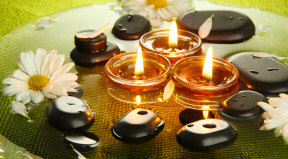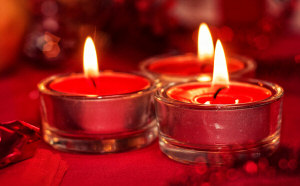Proper Candle Care and Safety Tips
 Burning
candles fills your home with the aroma of your favorite scents, creating a warm
and inviting atmosphere. If you’re an avid candle user, you know that the best
candles are often expensive to purchase but they burn longer and with a truer
scent than cheaper versions. However, I have discovered that many people who
love candles often care for and use their candles improperly, shortening the
lifespan of the candles and even creating potentially dangerous situations. By
following a few simple rules, you can extend the life of your candles and avoid
common mistakes which may lead to injury or fire in your home. Burning
candles fills your home with the aroma of your favorite scents, creating a warm
and inviting atmosphere. If you’re an avid candle user, you know that the best
candles are often expensive to purchase but they burn longer and with a truer
scent than cheaper versions. However, I have discovered that many people who
love candles often care for and use their candles improperly, shortening the
lifespan of the candles and even creating potentially dangerous situations. By
following a few simple rules, you can extend the life of your candles and avoid
common mistakes which may lead to injury or fire in your home.
Storing Your Candles
Many people buy candles for special events such as holidays or special
dinners that are only used a few times a year. For candles that are not often
used, proper storage is essential to prevent damage and keep your candles
looking their best.
- Always store your candles in dark, cool, dry place such as a cabinet,
closet or box. Exposing your candles to bright sunlight or artificial
lighting will fade the color of your candles over time. Taper candles and
boxed candles (such as tea lights) should be stored flat to prevent warping.
- Do not pile too many candles on top of each other. Excess weight can
damage your candles and even affect their scent. To avoid scent transfer,
keep scented candles in their original packaging. This will help to prevent
the scent from fading and mixing with your other candles. Candles that are
no longer in their original packaging should be wrapped in plastic wrap.
- To prevent candles from chipping while stored, place tissue paper or
bubble wrap in between your candles.
- Do not store your candles in the freezer! Although this popular wive’s
tale persists, storing your candles in the freezer will cause the wax to
crack and not all of the cracks may be visible. This is especially true of
taper candles, which are thinner, and lighting a candle with a crack is a
potential fire hazard.
- Remove dust and dirt from the surface of your candles with a dry or
slightly water dampened piece of cloth.
Candle Safety Tips
 Using
your candles properly is of the utmost importance. Remember, this is an open
flame burning in your home. You must take care to place your candles in safe
places and practice proper burning techniques. At best, an improperly placed
candle will damage carpeting and furniture with hot wax. In the worst case
scenario, a candle can cause a fire in your home. According to the National
Candle Association, an excess of 15,000 candle fires are reported each year.
Many of these fires were a result of improper burning procedures and candle
misuse. Follow these candle safety tips to prevent your home from becoming
another candle fire statistic. Using
your candles properly is of the utmost importance. Remember, this is an open
flame burning in your home. You must take care to place your candles in safe
places and practice proper burning techniques. At best, an improperly placed
candle will damage carpeting and furniture with hot wax. In the worst case
scenario, a candle can cause a fire in your home. According to the National
Candle Association, an excess of 15,000 candle fires are reported each year.
Many of these fires were a result of improper burning procedures and candle
misuse. Follow these candle safety tips to prevent your home from becoming
another candle fire statistic.
- Using a glass container that is not qualified for candle burning is
never recommended. Glass that is not rated for burning candles can crack and
even shatter resulting in injuries and fire. Never use everyday glassware
for your candles.
- Do not use sharp objects such as knives to remove wax from your candle’s
jar or candle holder. Scratching the surface of the glass can weaken its
integrity and cause it to break when the candle is lit.
- Always keep an eye on any candles that are burning in your home. Never
leave candles lit when you leave, even if you only plan to be gone for a few
minutes. Extinguish all candles before going to bed at night.
- To reduce the risk of fire and injury, place all candles out of the
reach of pets and children. Never place candles in precarious places such as
small ledges, window sills, or the edges of tables and other furniture.
Doing so places your candle at greater risk of being knocked over. Always
place candles on solid, stable surfaces.
- Never place candles near flammable items such as curtains, on carpeting,
furniture, books, near chemicals or bedding.
- Trim candle wicks to ¼ inch before each use. Untrimmed candles wicks can
cause uneven burning and wax dripping. This can damage surfaces and increase
the risk of fire.
- Keep the wax pool of your candle free of debris and remove any wick
trimmings or matches before lighting.
- Always use candles in well ventilated areas. Burning a candle in a small
space can affect the exchange of oxygen and result in breathing problems.
- Never place a candle in front of a draft, fan or direct air current such
as a window.
-
 Read
and follow the manufacturer’s instructions on your candle. Do not burn the
candle for longer than recommended and never burn the candle all the way
down. Although you may be tempted to get the last bit of scent from your
candle, exceeding the safe burning limit can result in injury and fire.
Candles should not continue to be used when they are with ½ inch of the
bottom of the jar. Candles in votives and holders should not be used when
only 2 inches of wax remains. Read
and follow the manufacturer’s instructions on your candle. Do not burn the
candle for longer than recommended and never burn the candle all the way
down. Although you may be tempted to get the last bit of scent from your
candle, exceeding the safe burning limit can result in injury and fire.
Candles should not continue to be used when they are with ½ inch of the
bottom of the jar. Candles in votives and holders should not be used when
only 2 inches of wax remains.
- Any candles that exhibit a higher than normal flame, begin smoking or
flickering consistently should immediately be put out. This is a sign that
your candle is not burning properly and the flame is uncontrolled.
Extinguish the flame and allow the candle to cool completely. Check the wick
length and ensure no drafts are present in the candle’s location.
- Never move a lit candle or an extinguished candle whose wax has not
solidified.
- Groups of candles should be at least 3 inches away from each other to
prevent excess melting and the creation of their own draft. Placing candles
3 inches apart allows air to flow freely between them ensuring proper
burning and reducing the risk of fire.
- Never blow on your candles or use water to extinguish the flame. This is
a dangerous practice which can cause wax to spatter and burn you or others.
Using water may cause the candle’s glass container to shatter. Use a candle
snuffer to safely extinguish your candles.
- Never place jarred candles on candle warmers. Candles warmers are not
meant for glass containers and the heat can cause the jars to crack and even
explode.
Final Words
Candles can be a delightfully fragrant way to add warmth and ambiance to your
home. However, you must make sure to follow proper candle safety techniques to
prevent injury and fire from occurring in your home.
DIY
8 Steps to Give Yourself a Manicure at Home
Proper Candle Care and Safety Tips
Top 30 Unexpected Uses for Coca-Cola
Homemade Fabric Softener
Homemade Orange Cleaner
20 Uses for Reused Dryer Sheets to Clean Your Home
Easy Homemade Fabric Refresher
Save $$ Using Homemade Laundry Soap
My Blacklight Garage Party Room |